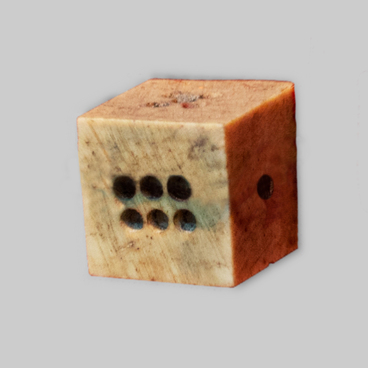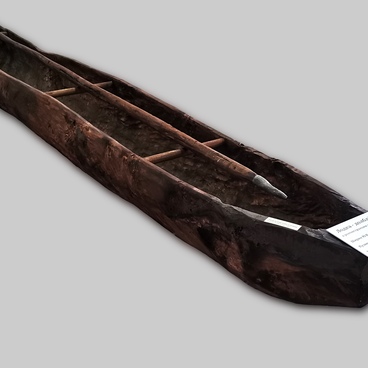A chess piece from the museum collection dates back to XVII–XVIII centuries. The chess piece was cut out of a bone. There are several tiers on a flat base, with a broad-brimmed sharp peak at the top. The chess piece is an artifact from Kuznetsk ostrog excavations.
The researchers also found hand-made chess pieces in other Siberian cities: Mangazeya, Tobolsk, Tomsk, Yeniseisk. In Mangazeya, the chessboards were also encountered for the first time.
Chess was one of the most popular games in Russia in XVII century. In Ancient Rus playing chess was deemed to be gambling – playing ‘kostArnye “games (crap shooting). Games where bone cubes – dice – were used were deemed gambling as dice brought in an element of luck. But if with the dice, whether you lose or win fully depended on your luck, in chess, luck was combined with the play of mind.
Despite a strict ban on gambling in the Czar”s Edict, Council Code and “The DomostrOy” (The Household Management Code), Kuznetsk service class people found time to fabricate and use the playing accessories. If gambling was discovered, the woywode (governor) had to confiscate all relevant articles and burn them. The game participants were subject to whipping, the game organizers were subject to imprisonment and asset seizure in favor of the state, and persistent gamblers caught in the act for the fourth time faced death penalty.
Сhess history dates back ca. 1500 years. Their oldest known predecessor is likely to be an Indian game chaturanga. It was borrowed by the Persians who changed the rules and called the game shatrAnj. After the Arab conquering of Persia in VII century, Shatranj spread within the limits of the Islamic Caliphate, and the Europeans learnt about it from the Arabs.
The game became more similar to the contemporary chess late in XV century — it was in those times that the moves were assigned to Bishop and the Queen, existing in the chess game nowadays. Previously, they had limited mobility. The entire game changed significantly: it became faster, the white pieces got the advantage of the first move. That resulted in the appearance of chess openings where the white pieces prepare attacks at an early stage of the game, and stimulated the development of chess opening theory.
In the Russian sources the word “chess” is first encountered in XIII century, though hoards with chess pieces were found, dating XI–XII centuries. The word itself most likely traces its origin to the Persian language, meaning “deliver mate”.
Developed commercial relationship with the Islamic Caliphate and eastern origin of the chess pieces allowed the archeologist Ivan Savenkov and chess historian Isaac Linder to assume that the East Slavs first encountered chess even earlier, approx. between VIII and X centuries. Shatranj could be brought to Rus either directly from Persia through the Caucasus and Khazar kaganat, or from the Asian nations, through Khwarezm. The words “elephant” (the name of Bishop in Russian) and “ferz” (the name of the Queen in Russian) evidence borrowings from the east as they are literal translations from the Arab or Persian languages.
The researchers also found hand-made chess pieces in other Siberian cities: Mangazeya, Tobolsk, Tomsk, Yeniseisk. In Mangazeya, the chessboards were also encountered for the first time.
Chess was one of the most popular games in Russia in XVII century. In Ancient Rus playing chess was deemed to be gambling – playing ‘kostArnye “games (crap shooting). Games where bone cubes – dice – were used were deemed gambling as dice brought in an element of luck. But if with the dice, whether you lose or win fully depended on your luck, in chess, luck was combined with the play of mind.
Despite a strict ban on gambling in the Czar”s Edict, Council Code and “The DomostrOy” (The Household Management Code), Kuznetsk service class people found time to fabricate and use the playing accessories. If gambling was discovered, the woywode (governor) had to confiscate all relevant articles and burn them. The game participants were subject to whipping, the game organizers were subject to imprisonment and asset seizure in favor of the state, and persistent gamblers caught in the act for the fourth time faced death penalty.
Сhess history dates back ca. 1500 years. Their oldest known predecessor is likely to be an Indian game chaturanga. It was borrowed by the Persians who changed the rules and called the game shatrAnj. After the Arab conquering of Persia in VII century, Shatranj spread within the limits of the Islamic Caliphate, and the Europeans learnt about it from the Arabs.
The game became more similar to the contemporary chess late in XV century — it was in those times that the moves were assigned to Bishop and the Queen, existing in the chess game nowadays. Previously, they had limited mobility. The entire game changed significantly: it became faster, the white pieces got the advantage of the first move. That resulted in the appearance of chess openings where the white pieces prepare attacks at an early stage of the game, and stimulated the development of chess opening theory.
In the Russian sources the word “chess” is first encountered in XIII century, though hoards with chess pieces were found, dating XI–XII centuries. The word itself most likely traces its origin to the Persian language, meaning “deliver mate”.
Developed commercial relationship with the Islamic Caliphate and eastern origin of the chess pieces allowed the archeologist Ivan Savenkov and chess historian Isaac Linder to assume that the East Slavs first encountered chess even earlier, approx. between VIII and X centuries. Shatranj could be brought to Rus either directly from Persia through the Caucasus and Khazar kaganat, or from the Asian nations, through Khwarezm. The words “elephant” (the name of Bishop in Russian) and “ferz” (the name of the Queen in Russian) evidence borrowings from the east as they are literal translations from the Arab or Persian languages.



